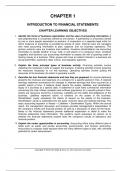Examen
Test Bank for Accounting Tools For Business Decision Making 8th Edition Paul D. Kimmel, Jerry J. Weygandt, Jill E. Mitchell || All Chapters | Newest Version 2024 A+
- Grado
- Institución
Test Bank for Accounting Tools For Business Decision Making 8th Edition Paul D. Kimmel, Jerry J. Weygandt, Jill E. Mitchell || All Chapters | Newest Version 2024 A+ CHAPTER 1 INTRODUCTION TO FINANCIAL STATEMENTS CHAPTER LEARNING OBJECTIVES 1. Identify the forms of business organization and the ...
[Mostrar más]




